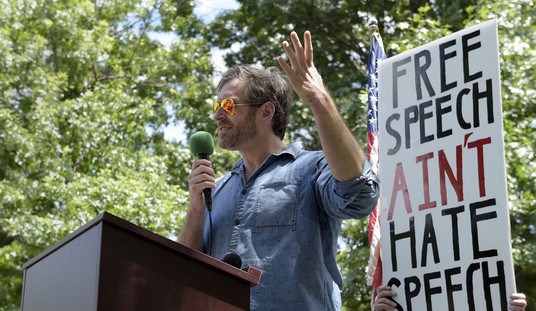If there was ever a time when a realistic counter to the climate scare was desperately needed, it was last month in San Francisco. Thousands of climate catastrophists invaded the city to attend the September 12-14 Global Climate Action Summit (GCAS), a massive event designed to drum up support for the Paris Agreement on climate change and to push the world to quickly end our use of fossil fuels.
In his video promoting the Summit, California Governor Jerry Brown said:
It’s up to you and it’s up to me, and tens of millions of other people to get it together to roll back the forces of carbonization and join together to combat the existential threat of climate change.
Let us be clear: Brown and his cohorts are not talking about “carbon.” They are talking about carbon dioxide (CO2) which is the opposite of pollution. Indeed, all vegetation thrives on CO2. But that honesty would not conjure up dark thoughts of soot, coal dust, and lamp black.
The “carbon” misnomer appears everywhere in climate change pronouncements. The Summit website even claimed “decarbonization of the global economy is in sight.”
Decarbonization actually means phasing out the fossil fuels that now provide over 80% of all the energy we use in favor of wind, solar, and other supposedly clean energy sources (which cannot conceivably power the world).
To contest the Summit, the Heartland Institute — labeled by The Economist magazine as “the world’s most prominent think-tank promoting skepticism about man-made climate change” — livestreamed two panel discussions of scientists and climate policy experts meeting at the conference center of The Independent Institute in Oakland, across the Bay from San Francisco.
Chaired by Heartland senior fellow James Taylor, the panel participants included Dr. Jay Lehr, Heartland’s science director; Dr. Terry L. Gannon of The Independent Institute; Dr. Richard Keen, meteorology instructor (emeritus), University of Colorado, Boulder; Miami, Florida-based hurricane meteorologist Stanley Goldenberg; and Tom Harris, Executive Director of the Ottawa, Canada-based International Climate Science Coalition.
While GCAS summit speakers — most of them scientifically illiterate celebrities, politicians, and environmentalists — appeared to be competing for the dubious distinction of making the most outrageous claims, Al Gore easily took first place. At the World Coal and Ice Forum, a September 13 side event at the Summit, Gore told the audience:
We have to make the decarbonization of the global economy the central organizing principle of human civilization in order to stave off the climate crisis in time to avoid the truly catastrophic consequences. It is a global emergency. People hear a phrase like that and it sounds a little hair-on-fire hyper. But this is an existential threat to the future of human civilization.
Using part of Gore’s quote to set the stage for Heartland’s panel, James Taylor replied:
That tells you everything you need to know. What Al Gore wants is a central organization of civilization. He doesn’t want individual freedom. He doesn’t want economic freedom. He doesn’t want people pursuing their own ends or even nations looking out for their own interest. He wants a central organization of civilization. And that’s the reason, at the Global Climate Action Summit, [featured] speakers are Van Jones, Nancy Pelosi, and John Podesta, because it’s about the ideologies and it’s about their ulterior motives that have nothing to do with the science.
Given that Hurricane Florence was lashing the southeastern United States at the time, much of Heartland’s panel focused on hurricanes and other tropical cyclones (TC), claimed to be increasing due to man-caused global warming. The panel emphasized that we are not in a period of unusual TC activity. After giving an update on Florence, Stanley Goldenberg stated:
We have not seen anything that indicates that we’re in an unprecedented time of more hurricanes or stronger hurricanes if you understand how to read the historical record. Because we can look back and say oh, well there’s more recorded right now, well that’s because we didn’t have satellite, we didn’t have the recon [weather reconnaissance aircraft], we didn’t have all sorts of other things to observe them out there. So, if you take those things into account, we’re not seeing anything unusual.
Tom Harris followed up by explaining that one way we know that TCs are not increasing is by examining the historical record of storm surges, the sudden rise in ocean level that accompanies a cyclone when it hits a coastal region. Harris said that the record was set by the Backerganj Cyclone in Bangladesh in 1876 which was 13.6 meters high (although the Australian government lists the Cyclone Mahina of March 5, 1899 in Bathurst Bay, Australia, as setting the record at 14.8 m, at the end of a cooling period). The maximum number of deaths from a TC storm surge, Harris told the panel, was about 300,000 in Bangladesh in Nov 1970 due to the 9 m storm surge set up by The Bhola cyclone. By contrast, Hurricane Sandy in 2012 was only 4 m — the problem was that the sea walls were only 1.5 m high. Harris concluded by stating that we need to copy India, which has built multi-story storm shelters every kilometer along the Bay of Bengal coast where most of the TCs hit.
Dr. Keen disputed that Sandy was a global warming-related disaster, and said:
I believe Sandy did have the highest storm surge level ever recorded in Manhattan. However, it did not have the highest storm surge itself, because Sandy occurred at high tide. The 1821 hurricane actually had a greater storm surge by several feet, but it occurred fortunately at low tide, and again, this was in 1821. So why was hurricane Sandy so devastating, and few of us has heard of the 1821 hurricane? Well, who lived in Sandy Hook, New Jersey in 1821 as compared to now? [The 1821 hurricane] did a bullseye right over Cape May, New Jersey. How many people lived in Cape May or Wildwood, New Jersey in 1821? A few intrepid fishermen who probably had the sense to get out of there well in advance.
Much of the discussion during the Heartland panels focussed on how climate catastrophists misuse the data to support the climate scare. Dr. Lehr summarized:
They take only the data that works to prove the point they’re trying to make: it’s called selective data [or junk science]. It goes against all science. In science, we have to look at all the data and make our conclusions based on it … The great Willie Soon at Harvard said that on climate models, if they actually used all the variables, it would take the largest computer on the planet 40 years to come up with the answers. So the opposition, the alarmists, just use whatever data that works for them, and it’s called cherry picking, and they do it very well. It’s absurd, but the public, not scientifically trained, do not understand it.
Holding up a carbon dioxide (CO2) measurement gauge, Lehr explained:
Since this whole meeting [the Global Climate Action Summit]is about carbon dioxide and there are six of us here, you want to accuse us of spewing hot air, we’ll have to say we’re guilty of that. The carbon dioxide level around this table in a relatively small room is around 1100. I’m willing to bet that at the climate summit, it’s over 2000. You don’t see any of us scurrying away fearful. It’s not a problem, we exhale ten times the amount that you find in the outside atmosphere. Carbon dioxide is nothing to be feared: the more, the better of it, and as I said yesterday, on submarines, underwater for a month at a time, a nuclear sub averages about 5,000 parts per million. So, if you’re afraid of carbon dioxide, now is the time to end that fear.
A good deal of the panel discussion centered around the supposed correlation between CO2 levels and Earth’s temperature. Dr. Gannon told the panel:
One of his [Elon Musk] … promotions of Tesla is that there is no explanation, no other explanation, for the increase in temperatures other than the rise in CO2. I have news for Mr. Musk: there are a great many studies that have been done — correlation, regression analysis — very detailed studies that show that that’s not true. There are a lot of natural causes that have been ignored by the climate models and by the people that are presenting in San Francisco as we speak … I think the Independent Institute has a bumper sticker called “Got Liberty.” I would ask that we generate another bumper sticker, “Got Science.”
But aren’t today’s temperatures unprecedented? No, Harris explained, citing historical climatologist Dr. Tim Ball who, in personal communication, sent the below graph and asserted: “it was warmer than today for at least 95% of the last 10,000 years.”

Keen trumped that statement by explaining:
Actually 90% of the time since creation the Earth was warmer than it is now because the geological evidence indicates that over all of geologic history’s 4.65 billion years, only between 5 and 10% of that time was there any substantial ice on Earth.
So, aren’t we climate change deniers? Again, no, explained Goldenberg:
As someone who has specialized in climate science much of my career, I definitely believe in climate change: the climate is always changing, that’s so important … you can’t stop the climate from changing. You can deal with certain anthropogenic contributions, man-made, however small they are, but there’s massive, well-documented, natural changes in the climate that have been going on for as long as we can do recorded history.
Finally, the panel discussed the disastrous consequences of the climate scare. Dr. Gannon summarized:
I only can ask: what about the people who are left behind? What about my friends in Africa? What about all the people that are below the poverty level? Will they ever have a chance if fossil fuels are indeed killed within the next few decades?
The answer is, of course, no. This “is going to devastate parts of the world,” Gannon concluded. James Taylor concluded the panel with a challenge:
At the Global Climate Action Summit and across the alarmist universe you see very little science presented. That which is presented is never encouraged or invited to be held up for scrutiny for discussion or debate. But on the other hand, we do so. The National Science Teachers Association said that we must not engage in this debate for ideological or political reasons. Instead, any such theories or assertions must stand up to existing empirical evidence and empirical testing.
At the Heartland Institute, at the Independent Institute, and at the many public policy organizations that are skeptical of a climate crisis, among the thousands of scientists skeptical of the alleged impending climate crisis, this is what we do: we stand up for sound science; we present evidence; we presented data to support what we are asserting. Anytime that we make the claims that we are not facing climate crisis, check out what supports what we’re saying, because if we don’t support it with scientific evidence, don’t believe it. But we do, and we do it much more than the other side.
The whole panel may be seen here.









Join the conversation as a VIP Member